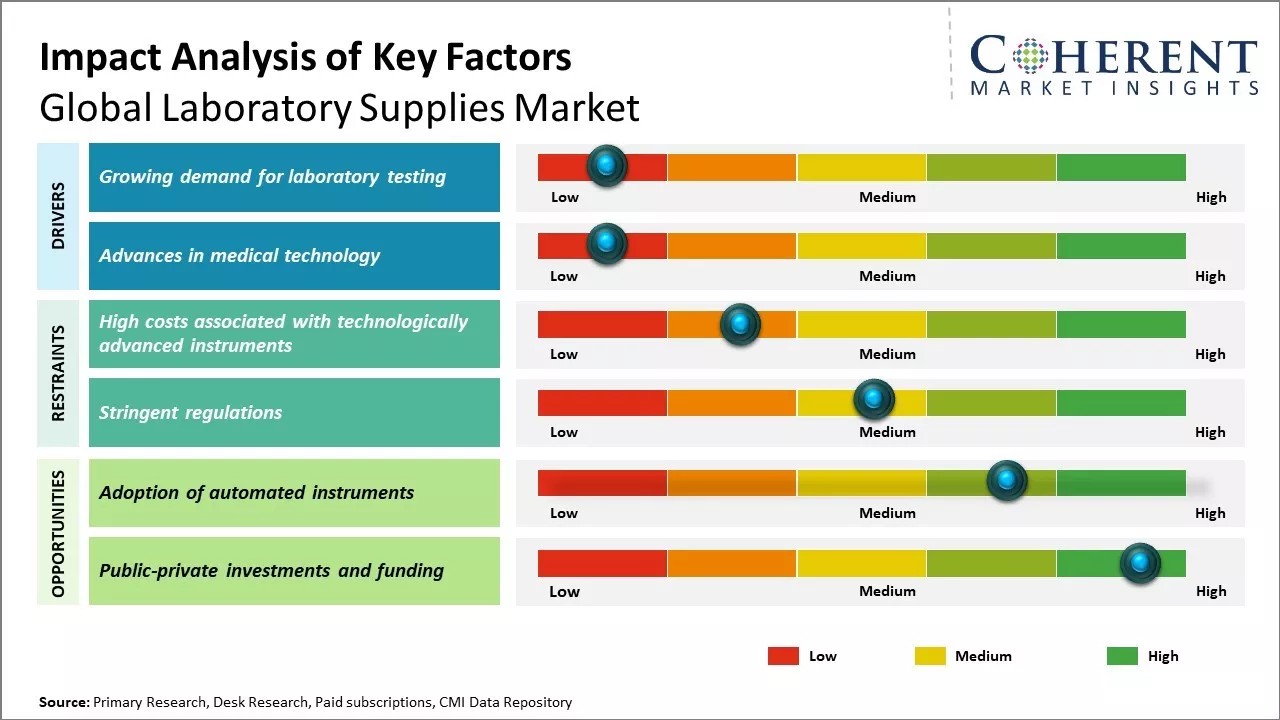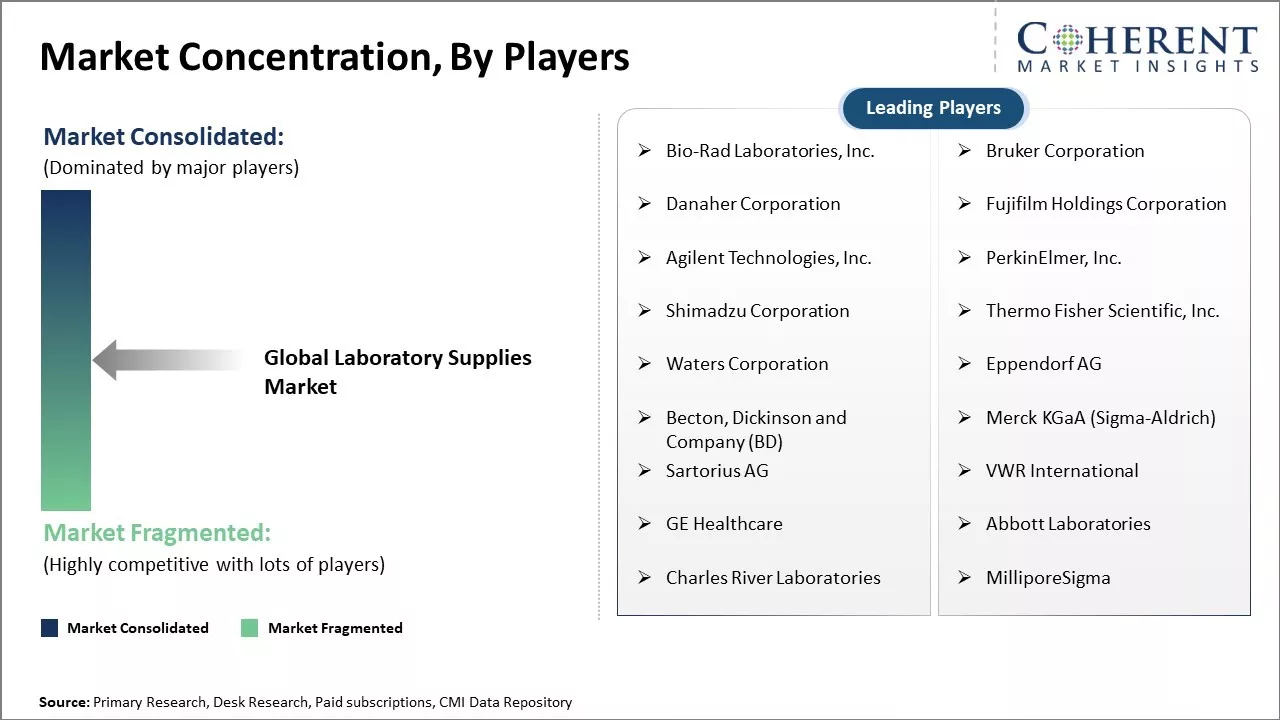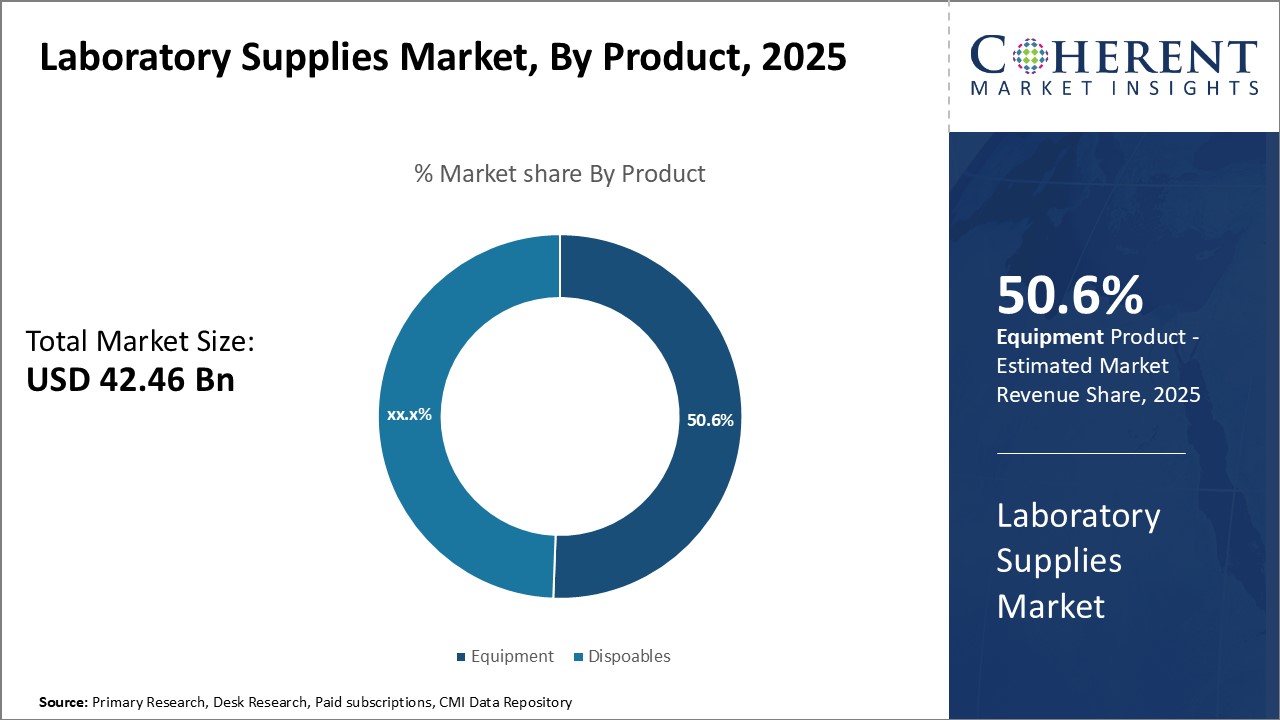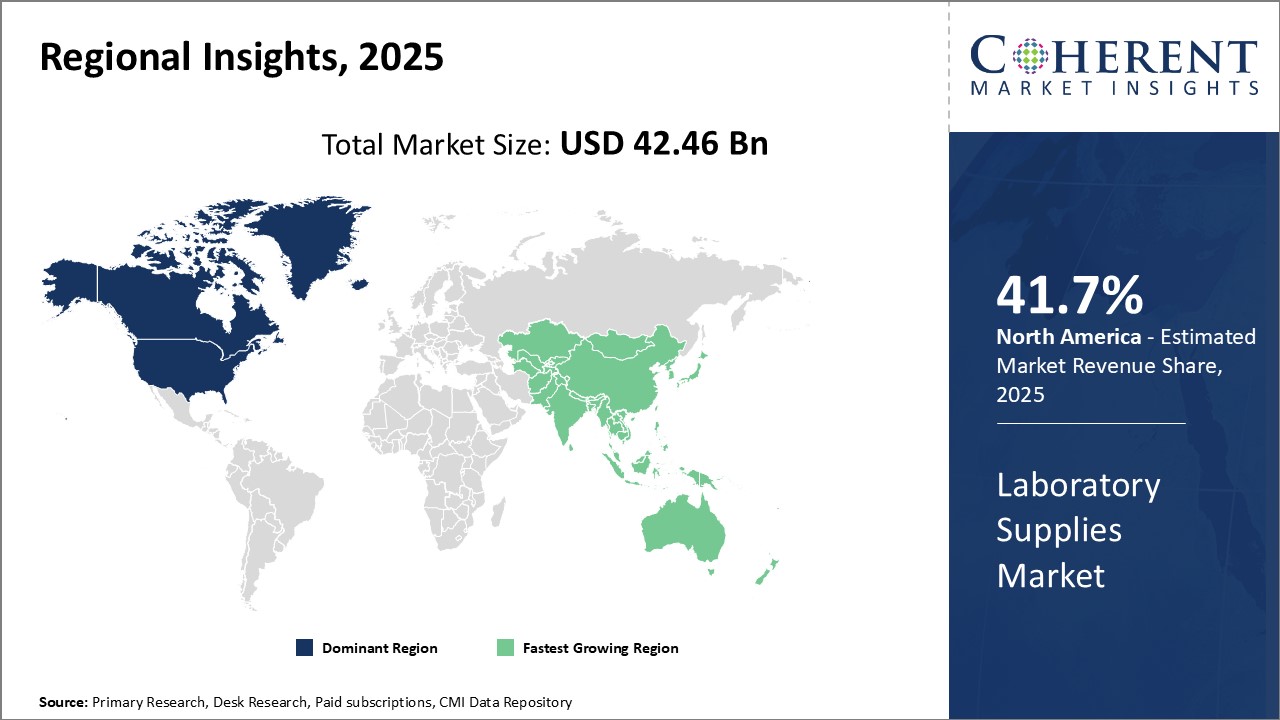Global laboratory supplies market is estimated to be valued at USD 42.46 Bn in 2025 and is expected to reach USD 74.24 Bn by 2032, exhibiting a compound annual growth rate (CAGR) of 8.3% from 2025 to 2032.

Discover market dynamics shaping the industry: Request sample copy
Global laboratory supplies market growth is driven by growing pharmaceutical & biotechnology companies globally. Rapid advancement in research areas such as drug discovery, genomics and cancer research can boost demand for advanced analytical instruments and consumables. Rising healthcare expenditures also boosts investments towards development of new medical technologies. However, high costs associated with procurement of technologically advanced analytical instruments can hamper the market growth. The pandemic has emphasized on strengthening healthcare systems worldwide, and this can drive the laboratory supplies market growth in the near future.
Growing demand for laboratory testing
Rising demand for laboratory testing services can drive the market growth. Due to increasing focus on preventive healthcare and rising awareness about various diseases, more people are opting for periodic health checkups. This has significantly increased the volume of tests being conducted across clinical laboratories. Moreover, growing geriatric population also boosts the number of diagnostic tests. Older people are more prone to chronic diseases and often require routine monitoring of various health parameters. Apart from individuals, there has been huge demand from hospitals and other healthcare facilities. With expanding in-patient and out-patient patient loads, hospitals now rely heavily on laboratory services to aid in diagnosis and disease management. Laboratories play a pivotal role in clinical decision making as these provide objective evidences through examination of bodily fluids and tissues. Their valuable inputs help doctors accurately determine the right treatment protocols. As healthcare costs increases globally, there is rising emphasis on precisely diagnosing medical conditions at the earliest to avoid additional treatment costs. This has boosted outsourcing of laboratory testing by hospitals.

Get actionable strategies to beat competition: Request sample copy
Advances in medical technology
Technological advancements have significantly expanded the breadth and depth of tests that can be performed in laboratories. Introduction of new and sophisticated analyzers, equipment as well as automation solutions have enabled laboratories to carry out a wide range of complex analyses with higher accuracy and precision. Automated systems have replaced manual processes, thus, improving productivity and throughput. Artificial intelligence and robotics are also finding increasing applications in various pre-analytical and post-analytical stages. Advances in fields like molecular diagnostics, genetics, proteomics and precision medicine have opened up new frontiers of diagnostic testing. Technologies such as polymerase chain reaction (PCR), next generation sequencing (NGS) and chromatography-mass spectrometry enable detection of diseases at a very early, sometimes presymptomatic stage by analyzing biomarkers, DNA, RNA or proteins. This allows for timely clinical intervention and personalized treatment options tailored to individual patient's molecular makeup and genomic alterations. The ability to efficiently sequence the human genome has revolutionized diagnosis of chronic and complex conditions including various forms of cancer.
Key Takeaways from Analyst:
Global laboratory supplies market is expected to witness growth over the next five years. North America currently dominates the market, owing to extensive R&D activities in the region. However, Asia Pacific is expected to be the fastest growing regional market due to increasing investments in life sciences research.
Rising investments in pharmaceutical and biotechnology R&D from global players looking to tap opportunities in emerging markets can drive the market growth. Growing prevalence of chronic and infectious diseases also boosts research to develop new diagnostic kits and assays. This can boost demand for consumables as well as equipment.
High costs of advanced laboratory equipment can restrict procurements from budget-constrained labs and research facilities in developing nations. Lack of proper infrastructure and stringent regulations can hamper the market growth in certain parts of Asia Pacific and Middle East & Africa.
To overcome these restraints, market players should focus on developing more affordable product offerings tailored for resource-constrained settings. Collaborations with regional research institutes may aid product awareness and education.
Growing biosimilars development and shift towards personalized medicine requiring specialized testing capabilities and consumables can offer market growth opportunities. Favorable regulatory policies supporting clinical and translational research can also offer growth opportunities.
Market Challenges: High costs associated with technologically advanced instruments
The high costs associated with technologically advanced instruments can hamper the laboratory supplies market growth. Modern scientific research requires the use of sophisticated laboratory equipment that can analyze complex biological and chemical samples accurately. However, these instruments come with a huge price tag running into hundreds of thousands or even millions of dollars. For example, a high-end mass spectrometer or electron microscope may cost upwards of US$ 500,000. Procuring and maintaining such capital-intensive supplies puts significant financial constraints on research budgets, especially for smaller labs and those operating in developing economies. The high initial investment required not only deters new entrants but also limits the scope of research that existing labs can undertake. Expensive instruments need to be imported from other countries since their development and production infrastructure is concentrated only among a few nations. This increases project costs manifolds due to tariffs and long delivery times. Moreover, advanced instruments also need specialized technicians for operation and periodic servicing. Their services do not come cheap and have to be paid for throughout the product lifecycle. All these factors associated with sophisticated lab supplies hike the total cost of ownership dramatically. As a result of the disproportionately high costs, many cash-strapped academic, clinical and government labs remain reluctant to procure expensive research-grade equipment. These continue relying on older, less technologically advanced instruments even though new ones promise higher accuracy and throughput. This has slowed the overall modernization and innovation in the sector.
Market Opportunities: Adoption of automated instruments
The laboratory supplies market has traditionally been dependent on manual processes that are time consuming and prone to errors. However, with increasing focus on boosting efficiency and accuracy, automated instruments are gaining more popularity among labs. These instruments integrate robotics, IoT and artificial intelligence to automate repetitive and mundane tasks, allowing researchers to focus more on higher-level work. For example, automated liquid handlers can replace manual pipetting which is more prone to repetitive stress injuries over long-term use. These can also pipette thousands of samples consistently without tiring, ensuring reproducibility. Such instruments improve throughput significantly while reducing chances of contamination. In 2021, as per report published by the UN Educational, Scientific and Cultural Organization (UNESCO), 72% of universities and research institutions surveyed planned to increase investments in automated lab equipment over the next 3 years to better handle high sample volumes and enhance COVID-19 related research. This growing demand allow vendors to innovate customized solutions for various tasks like sample preparation, detection, analysis and data management. Startups are also launching affordable robots and platforms to bring automation to smaller labs. As instruments get smarter with advancement in sensor technologies, artificial narrow intelligence and cloud connectivity, these can automate complicated workflows independently without extensive manual programming. This will make automation accessible to more classes of labs.

Discover high revenue pocket segments and roadmap to it: Request sample copy
By Product: Equipment: Driving Innovation in Laboratory Workflows
By product, equipment segment is expected to contribute the highest market share of 50.6% in 2025, owing to its critical role in modern research and testing. Advanced instruments have transformed virtually every area of work from DNA sequencing and compound screening to diagnostics and quality control. As scientific techniques become more sophisticated, there will be huge demand for cutting-edge analytical tools. Equipment purchases are often sizeable capital investments for laboratories. However, acquiring state-of-the-art devices helps boost efficiency, lower costs per test or experiment over time, and gain competitive advantages through new capabilities. For example, automated liquid handlers and high-throughput platforms have streamlined repetitive pipetting tasks and enabled high-volume screening of drug candidates or patient samples. Robotic systems also minimize human errors during complex multi-step protocols. Manufacturers continually refine existing equipment and introduce innovative new products. Integrating informatic systems allows seamless data capture from instruments into laboratory information management systems. Miniaturization and portability expand the applications of lab tools beyond traditional settings. Wearable and point-of-care devices bring diagnostics to the patient's bedside or even the home. Furthermore, the application of artificial intelligence and machine learning promises to enhance data interpretation from advanced analysis platforms. As scientific and medical research pushes the boundaries of knowledge, the demand for the latest and most powerful laboratory technologies remains robust. Whereas disposables are ultimately single-use, investments in high-performance equipment help maintain competitive advantages for years. This drives the equipment segment's dominance within the laboratory supplies market.
By End User: Clinical Testing Laboratories: Fulfilling Essential Healthcare Needs
By end user, clinical testing labs segment is expected to contribute the highest market share of 45 % in 2025. These perform a vast number of analyses essential for healthcare on patient samples, ranging from routine blood and urine tests to specialized molecular diagnostics and anatomic pathology exams. Major demand drivers center around serving basic population health requirements and facilitating better medical decision-making. An aging population undergoes more medical testing annually. Moreover, rising prevalence of chronic diseases also requires long-term patient monitoring. Early detection of illness through screening and diagnostics aids treatment outcomes. Regulatory standards require rigorous quality control and assurance programs within clinical labs. This ensures test accuracy and consistency in results. Adhering to quality standards sustains lab accreditations and certifications necessary to process insurance claims and service healthcare networks.

Need a Different Region or Segment? Customize now
North America dominates the global laboratory supplies market with 41.7% in 2025 due to presence of well-established life sciences industry and research institutions in the region. Countries like U.S. and Canada have robust pharmaceutical and biotechnology sectors undertaking intensive R&D activities. This has boosted demand for wide variety of laboratory consumables, equipment and technologies across various end-use industries. Moreover, presence of leading original equipment manufacturers (OEMs) such as Thermo Fisher Scientific, Agilent Technologies and Danaher Corporation has further strengthened North America's prominence in this industry. These players account for major share of laboratory supplies market in the region through their innovating product offerings and quality services.
Asia Pacific laboratory supplies market has been witnessing exponential growth, owing to increasing investments by governments and private players in life science infrastructure development. Countries like China, India, Japan and South Korea are emerging as global biomedical hubs luring huge capital investments for setting up world-class research institutes and labs. Rapidly developing healthcare sector and growing burden of diseases have necessitated higher spending on R&D activities. This has boosted the requirement for advanced laboratory tools and consumables to support clinical studies and diagnostic procedures. Presence of low-cost manufacturing destinations and favorable business landscape has attracted global players to establish manufacturing facilities in the region.
Laboratory Supplies Market Report Coverage
| Report Coverage | Details | ||
|---|---|---|---|
| Base Year: | 2024 | Market Size in 2025: | USD 42.46 Bn |
| Historical Data for: | 2020 To 2024 | Forecast Period: | 2025 To 2032 |
| Forecast Period 2025 to 2032 CAGR: | 8.3% | 2032 Value Projection: | USD 74.24 Bn |
| Geographies covered: |
|
||
| Segments covered: |
|
||
| Companies covered: |
Bio-Rad Laboratories, Inc., Bruker Corporation, Danaher Corporation, Fujifilm Holdings Corporation, Agilent Technologies, Inc., PerkinElmer, Inc., Shimadzu Corporation, Thermo Fisher Scientific, Inc., Waters Corporation, Eppendorf AG, Becton, Dickinson and Company (BD), Merck KGaA (Sigma-Aldrich), Sartorius AG, VWR International, GE Healthcare, Abbott Laboratories, Charles River Laboratories, and MilliporeSigma |
||
| Growth Drivers: |
|
||
| Restraints & Challenges: |
|
||
Uncover macros and micros vetted on 75+ parameters: Get instant access to report
*Definition: The laboratory supplies market caters to the needs of medical, academic, government, and industrial laboratories. It provides a wide range of consumables like tubes, reagents, jars, bottles, beakers, petri plates, pipettes, measuring cylinders, and syringes used in various processes like sample collection, preparation, testing, analysis, and storage. Instruments, equipment, and software solutions used in analytical testing and research activities are also provided. The laboratory supplies market aims to help laboratories conduct research efficiently and deliver accurate diagnostic results.
Share
Share
About Author
Nikhilesh Ravindra Patel is a Senior Consultant with over 8 years of consulting experience. He excels in market estimations, market insights, and identifying trends and opportunities. His deep understanding of the market dynamics and ability to pinpoint growth areas make him an invaluable asset in guiding clients toward informed business decisions. He plays a instrumental role in providing market intelligence, business intelligence, and competitive intelligence services through the reports.
Missing comfort of reading report in your local language? Find your preferred language :
Transform your Strategy with Exclusive Trending Reports :
Frequently Asked Questions
Joining thousands of companies around the world committed to making the Excellent Business Solutions.
View All Our Clients
US Reciprocal Tax Impact Analysis On Laboratory Supplies Market
Stay updated on tariff changes with expert insights and timely information